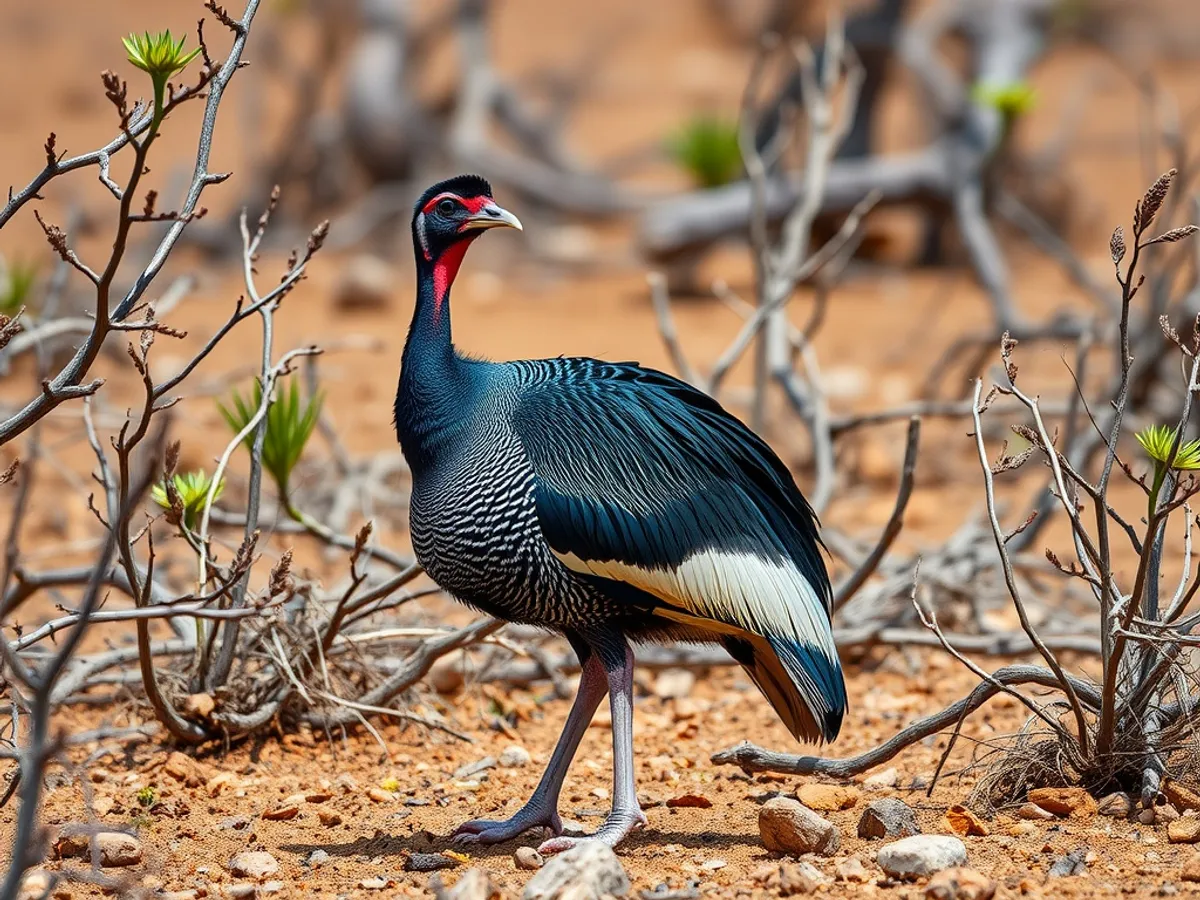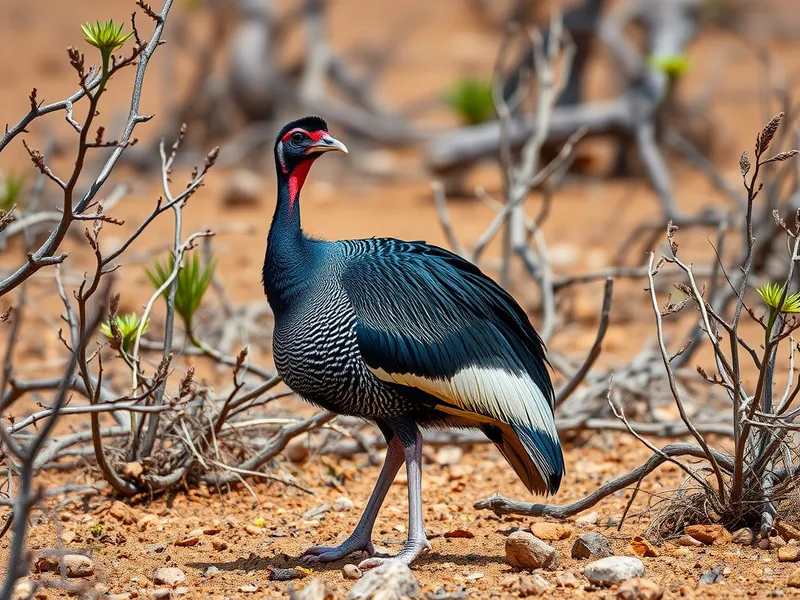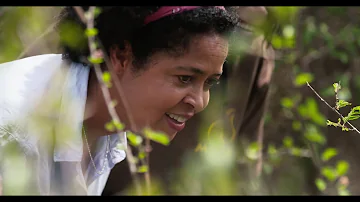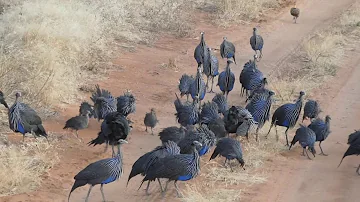
Vulturine Guineafowl
Acryllium vulturinum

Meet the Vulturine Guineafowl
The Vulturine Guineafowl is a striking, large bird native to eastern Africa, recognized by its vivid cobalt blue and black plumage accented with white streaks. It gets its name from its bare, bluish-gray head and long neck, which resemble those of a vulture. This species is highly social, forming large flocks that forage for seeds, insects, and small invertebrates on the ground. Vulturine Guineafowl prefer open habitats with scattered bushes and are known for their loud, raucous calls and elaborate group displays.
Classification
Bird
Habitat
Dry savanna and scrubland
Diet
Omnivore
Lifespan
10-15 years
Conservation
Least Concern
Weight
1.2-1.7 kg
📖Fascinating Facts
Striking Appearance
The Vulturine Guineafowl's vivid blue and black plumage, combined with a bare head and neck, makes it the most visually distinctive guineafowl species.
Fast Runners
These birds prefer to escape predators by running swiftly through the grass rather than taking flight, relying on their strong legs and agility.
Highly Social
Vulturine Guineafowl live in large, cohesive flocks with complex social behaviors, often performing group displays and cooperative vigilance.
📋Detailed Description
The Vulturine Guineafowl (Acryllium vulturinum) is the largest and most visually distinctive member of the guineafowl family, reaching up to 72 cm (28 in) in length and weighing between 1.2 and 1.7 kg. Its elongated neck and bare, bluish-gray head give it a vulture-like appearance, a trait unique among guineafowl. The body is adorned with iridescent cobalt blue feathers, sharply contrasted by long, lanceolate white streaks and black plumage, especially on the breast and flanks. The wings are short and rounded, adapted more for running than sustained flight. The legs are long and robust, equipped with strong claws for scratching the ground in search of food. Both sexes are similar in appearance, though males are slightly larger and may have longer hackles. The species is highly gregarious, often forming flocks of 20–50 individuals outside the breeding season, and even larger aggregations at water sources. Their vocalizations are loud and varied, including cackles and alarm calls, which serve both as communication within the group and as a deterrent to predators. Vulturine Guineafowl are primarily terrestrial, spending most of their time foraging on the ground and only taking to the air when threatened. Their social structure is complex, with dominance hierarchies and coordinated group movements. They are well-adapted to the arid and semi-arid savannas of East Africa, where they play an important role in seed dispersal and invertebrate population control.
💡 Did you know?
Despite their vulture-like appearance, Vulturine Guineafowl are not related to vultures at all; their bald head helps keep them cool in hot savanna climates.
🔬Research & Sources
Wikipedia Summary
The vulturine guinea fowl is the largest extant species of guinea fowl. Systematically, it is only distantly related to other guinea fowl genera. Its closest living relative, the white breasted guinea fowl, Agelastes meleagrides inhabit primary forests in Central Africa. It is a member of the bird family Numididae, and is the only member of the genus Acryllium. It is a resident breeder in northeast Africa, from southern Ethiopia and Somalia through Kenya and just into northern Tanzania.
Last Modified: 5/27/2025
🎭Behavior & Social Structure
Vulturine Guineafowl are diurnal and spend the majority of daylight hours foraging in open areas, often moving in tight, coordinated groups to maximize vigilance against predators. Their diet is omnivorous, consisting mainly of seeds, bulbs, berries, and a wide variety of invertebrates such as beetles, termites, and ants. Foraging is typically done by scratching at the soil and leaf litter with their strong feet. Social interactions are frequent and include mutual preening, synchronized dust-bathing, and communal roosting in trees at night for safety. The species exhibits a clear dominance hierarchy, particularly among males, which is established and maintained through ritualized displays and occasional aggressive encounters. When threatened, the flock will freeze, scatter, or run swiftly rather than fly, only taking short, explosive flights as a last resort. During the hottest part of the day, they seek shade and rest, resuming activity in the cooler hours of morning and late afternoon.
👶Reproduction & Life Cycle
Breeding typically coincides with the onset of the rainy season, which varies regionally but generally occurs from March to May and again from October to December. Males engage in elaborate courtship displays, fanning their hackles and performing strutting movements to attract females. The species is believed to be polygynous, with dominant males mating with multiple females. Nests are shallow scrapes in the ground, often concealed under dense vegetation. Females lay clutches of 4–8 cream-colored eggs, which are incubated solely by the female for about 23–26 days. Chicks are precocial, leaving the nest within hours of hatching and foraging alongside the adults. Both parents, and sometimes other flock members, assist in protecting and guiding the young, which are vulnerable to predation during their first few weeks.
🛡️Adaptations & Survival
Vulturine Guineafowl have evolved several adaptations for survival in arid savanna environments. Their long legs and strong feet enable efficient terrestrial locomotion and digging for food. The bare head and neck facilitate heat dissipation, crucial in hot climates. Their cryptic coloration when at rest and sudden, explosive flight help evade predators. Social living enhances predator detection and defense, while complex vocalizations aid in group cohesion and alarm signaling. Their digestive system is adapted to process a wide variety of seeds and tough plant material, as well as animal prey. The species' ability to exploit both plant and animal food sources allows them to thrive in habitats with fluctuating resource availability.
📚Research Sources
🎨Cultural Significance
Vulturine Guineafowl have limited but notable cultural significance in East African societies. Their striking plumage is sometimes used in traditional ceremonies and as decorative ornaments. In some regions, they are hunted for food, though less so than other game birds due to their wary nature and tough meat. The species occasionally appears in local folklore, symbolizing vigilance and group cooperation. They are also valued by ecotourism operators for their spectacular appearance and social behaviors, contributing to wildlife-based tourism economies.
🔬Recent Research & Discoveries
Recent genetic studies have clarified the phylogenetic position of Acryllium vulturinum, confirming its distant relationship to other guineafowl and close affinity with the forest-dwelling Agelastes genus. Ongoing research is examining their social structure, with evidence suggesting complex fission-fusion dynamics and possible cooperative breeding behaviors. Studies using GPS tracking have revealed extensive daily movements and habitat preferences, informing conservation management. There is growing interest in their role as seed dispersers and invertebrate predators, highlighting their ecological importance in savanna ecosystems. Long-term monitoring is needed to assess population trends in the face of environmental change.
🎥Wildlife Videos

VULTURINE GUINEA FOWLS S.1 E.4
Paula Kahumbu joins Wildlife Warrior Brendah Nyaguthii at Mpala Research Centre, to learn about the vulturine guinea fowls.
Wildlife Warriors

The Vulturine Guineafowl
A beautiful and amazing bird!!! Taxonomic Ranking: Domain = Eukaryota Kingdom = Animalia Phylum = Chordata Clade ...
WinterWolf

Vulturine Guinea fowl Buffalo springs reserve
The vulturine guinea-fowl is one of natures true beauties. The stunning basalt blue plumage is stunning. Looking at their heads, ...
ALAN JEFFREY

Vulturine Guineafowl family meeting, Samburu August 2018
We saw these two vulturine Guineafowl families on our afternoon game drive having a meeting on the road and then very quickly ...
Juliane Dietrich-Siedow

Vulturine Guineafowl VS snake #snake#Guineafowl #maternal_love #birds #wildlife #zoo #animals
Sora_Studio

Vulturine Guineafowl. Explore.org 29 March 2024
Loads of babies in this family of Vulturine Guineafowl at Mpala! :-) Courtesy of Explore.org Link to live cam: ...
Arlene Beech
🌍Habitat Information
The Vulturine Guineafowl typically inhabits Dry savanna and scrubland environments. Vulturine Guineafowls have adapted to their environments with specialized features and behaviors.
Primary Habitat:
Dry savanna and scrubland
More detailed habitat information will be available soon.
🛡️Conservation Status
The Vulturine Guineafowl is currently classified as Least Concern. Conservation efforts are crucial for preserving this species for future generations.
Common Threats:
- 🏠Habitat loss and fragmentation
- 🌡️Climate change impacts
- 🎯Hunting and poaching
- 🏭Human-wildlife conflict
⚠️Threats & Conservation Challenges
Currently classified as Least Concern by the IUCN, the Vulturine Guineafowl faces localized threats from habitat loss due to agricultural expansion, overgrazing by livestock, and hunting for food and feathers. In some areas, human encroachment and fragmentation of savanna habitats have led to population declines. However, the species' wide distribution and adaptability to secondary habitats have buffered it from severe global declines. Predation by raptors, mammals, and reptiles is a natural challenge, particularly for eggs and chicks. Climate change, with its potential to alter rainfall patterns and vegetation structure, may pose future risks to their preferred habitats.
🔬Scientific Classification
Scientific Name
Acryllium vulturinum
Classification Hierarchy
🔍 About Taxonomic Classification
Taxonomic classification is a hierarchical system used by scientists to classify and organize living organisms based on shared characteristics and evolutionary relationships.
The system moves from broad categories (Kingdom) to increasingly specific ones, with each animal's scientific name typically consisting of its Genus and species.
📝Community Notes
Share your observations and insights about the Vulturine Guineafowl with our community of wildlife enthusiasts.
Join Our Community
Sign in to share your observations and connect with fellow wildlife enthusiasts.
Sign In to ContributeNo community notes yet
Be the first to share your observations about the Vulturine Guineafowl!
Explore Vulturine Guineafowl
Select a tab above to learn more about this amazing animal.
📸Photo Gallery
No photos available for this animal yet.
🌟Discover More Wildlife
Continue your journey of discovery with more fascinating animals from our database
